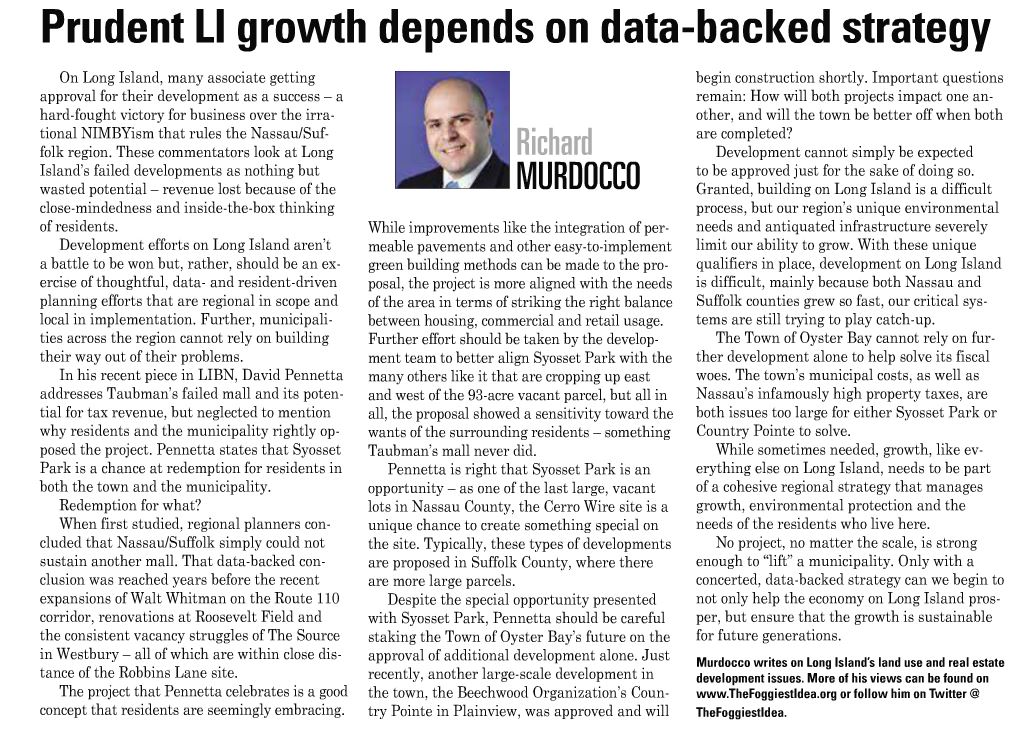The following was written for the June 5, 2015 edition of Long Island Business News.
On Long Island, many associate getting approval for development as a success – a hard fought victory for business over the irrational NIMBYism that rules the Nassau and Suffolk region. These commentators look at Long Island’s failed developments as nothing but wasted potential – revenue lost because of the close-mindedness and inside-the-box thinking of residents.
Development efforts on Long Island aren’t a battle to be won, but rather, should be an exercise of thoughtful, data and resident driven planning efforts that are regional in scope, and local in implementation. Further – municipalities across the region cannot rely on building their way out of their problems.
In his recent piece entitled Syosset Plan Poised to Lift Oyster Bay, frequent LIBN Columnist David Pennetta waxes poetic about Taubman’s failed mall and it’s potential for tax revenue, but fails to mention why, exactly residents and the municipality rightly opposed the project – Pennetta states that Syosset Park is a chance at redemption for residents in both the Town and the municipality.
Redemption for what?
When first studied, regional planners concluded that the Nassau/Suffolk region could not simply sustain another mall. That data-backed conclusion was reached years before the recent expansions of Walt Whitman on the Route 110 corridor, renovations at Roosevelt Field, and the consistent vacancy struggles of the Source in Westbury – all of which are within close distance of the Robbins Lane site.
The project that Pennetta celebrates in his piece, Syosset Park, is a good concept that residents are seemingly embracing. While improvements like the integration of permeable pavements and other easy-to-implement green building methods can be made to the proposal, the project is a more aligned with the needs of the area in terms of striking the right balance between housing, commercial and retail usage. Further effort should be taken by the development team to better align Syosset Park with the many others like it that are cropping up east and west of the 93-acre vacant parcel, but all in all, the proposal showed a sensitivity towards the wants of the surrounding residents – something Taubman’s mall never did.
Pennetta in his piece did correctly state that Syosset Park is an opportunity – as one of the last large, vacant lots in Nassau County, the Cerro Wire site is a unique chance to create something special on the site. Typically, these types of developments are proposed in Suffolk County, where there are more large parcels.
Despite the special opportunity presented with Syosset Park, Pennetta should be careful staking the Town of Oyster Bay’s future on the approval of additional development alone. Just recently, another large scale development in the Town, the Beechwood Organization’s Country Pointe in Plainview, was approved and will begin construction shortly. Important questions remain – how will both projects impact one another, and will the Town be better off when both are completed?
Development cannot simply be expected to be approved just for the sake of doing so. Granted, building on Long Island is a difficult process, but our region’s unique environmental needs and antiquated infrastructure severely limit our ability to grow. With these unique qualifiers in place, development on Long Island is difficult, mainly because both Nassau and Suffolk Counties grew so fast, our critical systems are still trying to play catch up.
The Town of Oyster Bay cannot rely on further development alone to help them solve their fiscal woes. The Town’s municipal costs, as well as Nassau’s infamously high property taxes, are both issues too large for either Syosset Park or Country Pointe to solve.
While sometimes needed, growth, like everything else on Long Island, needs to be part of a cohesive regional strategy that manages growth, environmental protection and the needs of the residents who live here.
No project, no matter the scale, is strong enough to “lift” a municipality. Only with a concerted, data-backed strategy can we begin to not only help the economy on Long Island prosper, but ensure that the growth is sustainable for future generations.
Rich Murdocco writes on Long Island’s land use and real estate development issues. He received his Master’s in Public Policy at Stony Brook University, where he studied regional planning under Dr. Lee Koppelman, Long Island’s veteran planner. Murdocco contributes weekly to the Long Island Press. More of his views can be found on www.TheFoggiestIdea.org or follow him on Twitter @TheFoggiestIdea.












